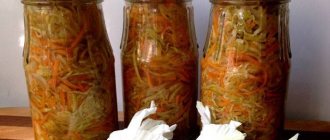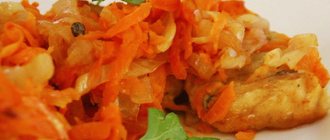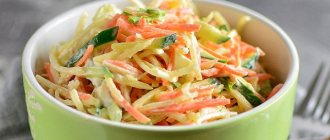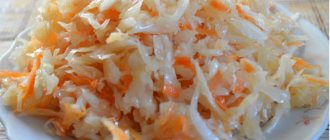Principles for selecting varieties for winter storage
The ability of vegetables to maintain commercial quality for a long time without being exposed to various diseases and without losing weight is characterized by the specific term “keeping quality”.
When choosing a variety suitable for storage, they are guided by the speed of ripening and the expected harvest date . The dependence of the shelf life index on the duration of the growing season is shown in the table:
| Varieties | Maturation speed | Fruit size | Growing season duration | Keeping quality |
| Parisian carotel 443 | Early | Short | 60–90 | Cannot be stored |
| NIIOH-336, Chantanay, Nantes | Mid-season | Middle length | 90–115 | Up to 4 months |
| Berlicum, Nuance, Forto | Late ripening | Large, long | 110–130 | 6–7 months |
Shortened root vegetables with a shortened ripening period (Paris carotel) spoil first. Late-ripening carrots with long conical fruits (Valeria, Forto, Vita Longa, Moscow winter) are stored better than other varieties. Weather anomalies can make amendments to this pattern. For example, with a long spring and early autumn, the growing season of carrots is reduced. During the short summer, late-ripening varieties do not have time to accumulate sufficient amounts of sugar and fiber, as a result of which the shelf life of root crops decreases. Early varieties are stored better under similar conditions.
It should be understood that choosing a mature variety does not guarantee crop protection. The safety of root crops depends on a combination of factors, each of which is of decisive importance. This includes the timely implementation of all agrotechnical measures taking into account the climatic characteristics of the area, pest control, and preparation of storage areas. Failure to comply with even one condition may ruin all efforts.
Regional features
The productivity and germination of carrots depends not only on proper and timely care, but also on the climate of the area in which it is grown. Therefore, before planting, you need to take these factors into account, and then a rich harvest will be ensured.
Middle Strip
For this area, it is necessary to choose a variety that is early ripening and resistant to low temperatures and various diseases.
The best varieties for this area are:
Carrots of the above varieties are distinguished by their rich yield, and their fruits are colored bright orange.
Ural and Siberia
In the Urals and Siberia, the weather can be varied, which in turn does not always have a favorable effect on this crop during the growing period. However, breeders do not stand still, but are constantly developing new hybrids and varieties that will bear fruit well even in a given area.
Varieties for the Urals and Siberia:
The main feature of the varieties grown in Siberia is their unpretentiousness to soil and care. Even with minimal effort, you can get quite a decent harvest.
Late-ripening varieties for storage
The Queen of Autumn is characterized by disease resistance, so it can be stored for a long time.
Late varieties are considered to be those that ripen 120–140 days after germination. These carrots are characterized by increased cold resistance, less vulnerability to disease, and therefore are stored until next summer. The taste does not suffer during storage, and the beneficial properties are not lost. The best late-ripening varieties for storing for the winter:
- Queen of Autumn. Perhaps the most durable variety created by Russian breeders. Each carrot weighs almost 200 g and grows to impressive sizes. The length of the root crops is 25–30 cm. Approximately 120 days pass from the first shoots to technical ripeness. The variety is suitable for fresh consumption and preservation. The carrots are juicy, crispy and tasty. Stays until June. Storage does not affect commercial quality.
- Flaccoro. Dutch variety. Commercial maturity occurs 110–130 days after sowing. The carrot is bright orange, smooth, elongated, with tender flesh. The variety is productive - root crops grow up to 30 cm. The main advantage over other varieties is excellent keeping quality. Consumer properties are not lost until next summer.
- Vita Longa. A new relatively productive variety. The growing season is long – almost 140 days. Recommended for winter storage due to its excellent shelf life. It can also be used fresh. The weight of root crops is from 200 to 300 g, length up to 30 cm.
- Carlena. Productivity is high. Ripens 130 days after planting the seeds. Due to the high sugar content in root vegetables, it is not recommended for patients with diabetes. It is unpretentious and does not require special care when growing. If the required microclimate is observed, it will last until spring.
Which is best to choose?
Carrots are one of the most popular vegetables at any time of the year. Naturally, in order for it to be stored well, it is necessary to create the necessary conditions, but even a good cellar will not protect a carrot variety that is not intended for long-term storage. You need to choose only their special types.
Video of carrot varieties for winter storage:
Mid-season varieties
They perfectly retain their taste all winter. Here is a short description of them:
"Callisto F1". Carrots have a cylindrical shape. The pulp is particularly juicy; it does not contain the usual core. The skin is smooth.
"Viking". The fruits are cone-shaped, distinguished by juicy pulp and high carotene content.
"Nanates Tito." Cylindrical root vegetables can reach a weight of up to 170 grams. The variety is characterized by high productivity.
"Flakki F1". Its fruits can reach a length of up to 30 cm.
"Moscow Winter". A carrot with a blunt end and a small core. Can be stored until May.
"Perfection". Just like the previous species, it is distinguished by long, conical-shaped roots, but unlike it, it has a light core, which is coarser than the pulp.
"Typhoon". Its fruits grow of medium size. The vegetable has high taste characteristics.
"Forto F1". Root vegetables have practically no core, and their pulp is very tender and juicy.
What good carrot seeds are for open ground are indicated in the article.
Large
These varieties differ from others in the larger length and diameter of carrots. One of their fruits can weigh 200 grams. Due to their large size, root vegetables are well stored for a long time, and if damage occurs, they can be cut off, the remaining body will be enough for use.
"Nandrin F1". Such carrots ripen quickly in about 105 days. One vegetable can weigh up to 300 grams. The yield per 1 m2 is 8 kilograms. It is notable for the fact that it does not crack and has an excellent taste.
"Canada F1". It belongs to the late-ripening varieties. Its maturation lasts 130 days. The weight of one fruit ranges from 140 to 500 grams. Its flesh is quite juicy and sweet. This variety of carrots practically does not get sick.
Late varieties
They have to wait a long time for their ripening, but since the harvest occurs almost before the frost itself, the shelf life increases.
"Valeria 5". Orange fruits with a yellow center. This is a high-yielding species.
"Mo." Root vegetables reach 20 cm in length and weigh 160 grams. Excellent taste lasts until mid-spring.
"Leander". The cylindrical root vegetable has a medium core. It is all hidden in the ground, so there is no need to hill up such carrots. The weight of one piece is 100 grams.
"Olympus". The fruits have a pronounced conical elongated shape, have juicy pulp enriched with a rich carotene content. The variety is successfully stored until mid-April.
"Carlena." Root vegetables store well, have a cylindrical shape, a smooth surface and crispy flesh.
"Selecta". Its fruits are often used to prepare dishes for children, as they have excellent taste. They are of average size and weight.
What goes with green in women's clothing: fashionable and harmonious images with photos
"Coral". The pulp of this variety is dark orange in color. The weight of one fruit is 150 grams.
"Totem F1". The fruits are small in size, due to which they can be used for preservation in their entirety. This is a high-yielding variety of carrot.
Early
Unlike the previous variety, their fruits can be harvested within one and a half, or at the latest two, months after the appearance of the first shoots. Usually by mid-summer they are already ripe. This link will tell you how to thin out carrots in the garden.
"Touchon." It is notable for its medium-sized fruit with a flat brown end. The weight of the fetus can range from 93 to 172 grams. This variety is not afraid of diseases and can be stored for up to 5 months. From one planted hectare you can get about 40 tons of carrots.
"Nantes 4". Root crops of this variety can be harvested three months after the first shoots peck. One square meter yields about 6.5 kg of carrots. The medium-sized fruits have a bright orange tone. The weight reaches 160 grams.
Sweet varieties
For those who like to eat carrots raw, it is very important that their flesh is juicy and contains a lot of sugar, so it will be interesting for them to find out the varieties that meet these particular properties:
"Red Giant" Its fruits reach 24 cm and are dark orange in color. Can be stored until April.
Boltex. This variety is classified as mid-season. Its fruits have a conical shape with a blunt tip, their weight reaches 100 grams. Excellent taste remains until the beginning of summer.
"Wall". The variety is distinguished by medium-shaped fruits with a blunt end. They reach a mass of 150 grams. Its sweet fruits are used for canning, freezing and long-term storage.
"Losinoostrovskaya". There are a large number of “eyes” on the surface of root vegetables. A cylindrical carrot with a length of 18 cm can weigh as much as 160 grams.
What super-yielding tomatoes for greenhouses look like is described in this article.
You can see how to grow tomatoes in a greenhouse in the video in this article.
Which tomato varieties are best used for a polycarbonate greenhouse can be seen in the video in this article here: //gidfermer.com/sadovodstvo/ovoshhevodstvo/sorta-pomidor-dlya-teplicy-iz-polikarbonata.html
Keeping quality of mid-season varieties
Among the mid-season varieties, you can also choose several suitable for planting for the winter. Some of them are not inferior in keeping quality to the later ones:
- Samson. One of the most unpretentious varieties to cultivate. The growing season is from 110 to 115 days. Has improved taste. The length of the root crop is up to 20 cm with an average weight of 160–200 g. There is no core. But the pulp accumulates a lot of carotene, vitamins and microelements. Grows in areas of any degree of fertility. Suitable for cultivation in regions with any climate, resistant to spring return colds. Able to be stored until the next harvest, like many late-ripening varieties.
- Vitamin. The variety was bred specifically for long-term storage. It ripens 110 days after planting. The fruit grows up to 17 cm. It responds to care and sufficient watering with juiciness and excellent taste.
- Shantane. Mid-season high-yielding variety of carrots. The growing season is from 90 to 110 days. Root vegetables of excellent taste, each length is 15–17 cm, weight up to 250 g. They tolerate transportation well, do not crack in the garden or during long-term storage.
- NIIOH-336. Very tasty carrots. The root vegetable is red-orange, with a high content of carotene. By the time of ripening, it reaches a weight of 100-130g and grows up to 18 cm in length. It is cultivated everywhere, including in risky farming areas. The period from planting to harvesting is about 100 days. It has a high shelf life.
Viking
Viking carrot variety is excellent for winter storage. Carrots are a mid-season variety and have a high carotene content. This variety has excellent taste: the pulp of the root vegetable is juicy and tender. "Viking" is well stored and retains its presentation until spring.
Interesting fact: we owe the variety of orange carrots to the Dutch royal Orange-Nassau dynasty.
Early ripening varieties
Shantane is not afraid of heat, does not succumb to disease, and is resistant to bolting.
It is believed that early carrots are not suitable for storage. But if desired, some of the early ripening varieties remain until mid-winter. True, the planting dates will have to be adjusted. Information about the growing season is contained on the seed packets. Considering that carrot harvesting is expected to take place at the beginning of October or the end of September, the preferred planting date is calculated. So, if the growing season of a particular variety is 90 days, it should be sown no earlier than the end of June. In three months, the carrots will have time to ripen and will be suitable for storage. Subject to the recommended temperature conditions and fixed humidity, early and mid-early ripening carrots are stored without compromising their commercial quality for up to 4 months.
Tip #1. For summer planting of carrots, increased watering is necessary, otherwise the seeds will not germinate for a long time and the seedlings will dry out.
The following early ripening varieties are recommended as suitable for storage:
- Alenka. Reaches ripeness 80–85 days after germination. Carrots are tasty, juicy, smooth, and have the shape of a blunt cylinder. The crop requires good soil preparation and needs constant watering. With proper care, root crops grow up to 15 cm and weigh up to 100 g.
- Bangor. High-yielding hybrid, suitable for winter storage. It lasts for a long time, almost until spring. The root crop is large, cylindrical, contains a lot of sugars and carotene.
- Lagoon. A hybrid of Dutch selection. The start of collecting early products is possible 2 months after germination. But for the purpose of storing it, they remove it no earlier than the 85th day. Main advantages: pleasant taste, productivity, uniformity and presentation of root crops.
The mid-early variety Alenka, when properly stored, lasts almost until spring.
Autumn cares before winter to get an early carrot harvest
Sowing carrots before winter (more information about late planting of vegetables, as well as herbs and flowers) allows you to get strong and healthy shoots in the spring already at a temperature of only 3-4 degrees. At the same time, young seedlings can easily withstand temperatures down to -4 degrees. Thanks to this, the summer resident can get a very early harvest of large and juicy carrots. Taking into account the difference in weather conditions in different regions of the country, we begin planting this vegetable crop before winter only when morning frosts become regular and stable.
Winter planting of carrots includes important steps, the correct implementation of which determines the high yield of this valuable vegetable:
Site selection
Sunny areas (in extreme cases, slightly shaded) with light, loose and well-drained soils are ideal for growing carrots. It should be taken into account that maximum illumination is especially necessary for early varieties of vegetables. The garden plot for carrots must be reliably protected from strong and cold winds.
Required soil acidity for growing
Soils with a slightly acidic or slightly alkaline reaction are best suited for growing our vegetables. Planting carrots before winter on other fertile soils also gives good results. If the soil has an acidic reaction, it must first be treated with wood ash (1 cup) or chalk (350 g) - all per square meter. This crop grows very poorly on clay soils. It is also unacceptable to grow carrots in freshly manured areas. It is necessary to wait three or even four years before this area can be used for growing this crop, since on such soils the root crop often turns out to be hollow and contains unacceptable doses of nitrites.
We observe crop rotation
To sow vegetables before winter, we select areas where cruciferous crops (like cabbage) were previously grown. Carrots also produce a good harvest after potatoes. It is unacceptable to grow this crop for two years in a row in one place. To prevent the occurrence of diseases and pests in the same area, we grow carrots no earlier than 3-4 years.
Preparing beds for planting carrot seeds before winter
We completely clear the area for planting carrots from perennial weeds and plant debris. We dig the soil deeply and make beds with grooves. While digging the soil, we add fertilizers to it (per 1 sq. m): compost (bucket), superphosphate (25 g), potassium salt (10 g). Before planting vegetables, add nitrogen fertilizers (20 g) to poor soil. If the soil in the area chosen for carrots is heavy, it can be improved by adding semi-decomposed sawdust or river sand. This operation will prevent the formation of gnarled and ugly root crops.
We make the beds for vegetables more even and wide, since small seeds can simply be washed away when the snow melts. The ridges, located 20 cm apart from each other, should have a height of 15-20 cm. In order for them to be well preserved in all weather conditions, they can be strengthened with ordinary wooden boards. To prevent the ridges with furrows from being washed away by autumn rains, you can cover them with plastic film before sowing the seeds.
A very important stage in pre-winter planting of carrots is disinfection of the soil with a solution of copper sulfate, for carrying out the procedure we dissolve the contents of 1 table in a bucket of water. spoons. To completely disinfect the soil, adding 2 liters of this solution per 1 square meter is sufficient. m. beds. All soil preparation procedures must be completed before the end of October.
Sowing seeds
The depth of the furrows in heavy soils is 1 cm and 1.5 to a maximum of 2 cm in loose soils. After the first frost, we sow seeds in them and cover them with loose soil. Vegetable seeds should not be soaked before sowing. They must be dry. If you plant wet seeds before winter, they may germinate early and die. We mulch the top of the bed with sawdust or peat, maintaining a layer of at least 3 cm in height.
When sowing seeds, the main thing is to choose the right time. If the seeds manage to germinate before the onset of persistent cold weather, then all carrot seedlings will die. That is why it is preferable to sow seeds in slightly frozen soil. This usually occurs at the end of October or beginning of November (it all depends on the weather). In the area for carrots, it is necessary to take care of snow retention, since only good moisture when the snow melts in the spring will allow you to get an early and generous harvest. To ensure good snow cover in winter, you can lay cut branches or spruce branches on the beds. If possible, when removing snow from a summer cottage, we carefully dump it onto the vegetable beds to increase the thickness of the snow cover.
Spring carrot care
By spring, the seeds have time to become saturated with moisture while in the soil. In winter, they undergo natural hardening, which allows for very friendly shoots. To get vegetables to sprout earlier, after the snow melts, we clear the carrot beds of branches and spruce branches and cover them with plastic wrap. It will help retain moisture, perfectly increase the soil temperature and ensure the earliest seedlings.
When spring comes and the snow melts, it may become necessary to loosen the soil in the plantings. This must be done when its surface begins to dry out. This procedure is carried out with a ripper, using very careful movements, in order to avoid damage to the beds with crops. If in the spring the soil in the carrot beds is very dry, we provide it with a one-time weekly watering. You can also slightly clear the mulch layer on the beds. This will significantly accelerate the growth of seedlings.
Pest Control
Since practically no weeds grow in early spring, we begin to fight them only after they appear. 2 weeks after the emergence of seedlings, we begin to combat pests of vegetables. Carrots obtained by winter sowing are distinguished by their resistance to disease, but they can be damaged by various insect pests: carrot flies and aphids, psyllids, slugs, wireworms and fall armyworms. We use various drugs to control these pests. The most effective are Actellik, Decis, Aktara, Arivo, Sherpu, Sumicidin, Bazudin, Tsimbush.
PS Despite the fact that the word carrot is feminine, there are exceptions in nature that were achieved through systematic strict selection, in the form of “men” in these vegetables.
Mille pardons (French) for some frivolity!
Varieties and hybrids invulnerable to storage diseases
Bacterial, viral and fungal diseases cause great damage to gardeners when storing crops. Black, white, dry, gray, bacterial rot are widespread almost everywhere. An effective method of prevention is the choice of varieties that are resistant to disease. The names of such varieties are given in the table:
| Diseases | Varieties | F1 hybrids | Degree of stability |
| Black rot | Nantskaya 4, Supernant, Shantanay, Vita Longa, Cannery, NIIOH 336 | Gribovchanin, Cantenbury, Champion | Increased |
| Dry, brown rot (fomoz) | Nantskaya 4, Moscow Winter | Abaco, Bilbo | Relative |
| White rot | Incomparable, Grenada, Vitamin | There are no resistant hybrids | Relative |
| Gray rot | There are no resistant varieties | There are no resistant hybrids |
Tip #2. The safety of carrots depends on compliance with harvesting deadlines. Ripe root crops are less affected by diseases. The optimal period for harvesting carrots in the Non-Black Earth Region is from the end of September to the first ten days of October.
What parameters should you pay attention to when choosing?
Before purchasing seeds, you need to know what to look for and decide on its purpose. Carrots come with the highest glucose content and less, and are used as food or used as livestock feed. In addition, each variety has a certain shelf life, which also depends on the human factor.
Purpose
Due to its valuable composition, carrots are used not only for food and as pet food, they are also valued in folk medicine. Overweight people, thanks to this vegetable, can lose extra pounds.
It saturates the human body with vitamins and microelements.
Resistance to various diseases and pests
Not every carrot variety is disease resistant. Most often, the fruits and tops of this vegetable suffer from:
- Fungus.
- Virus.
- Various types of bacteria.
- Black, gray and white rot.
- Fomosa.
Throughout the entire growing period, a person may encounter any of the above diseases, regardless of the region and climate.
Pulp uniformity
Uniformity depends on many factors. For example, growing area, timely and proper care, etc.
The most popular varieties that are less susceptible to cracking are:
You can buy good quality seed only from trusted suppliers or in a specialized store.
Carotene and sugar content
The main indicator of the taste and quality of carrots is the presence of carotene and sugar in them in sufficient quantities. For example, people suffering from diabetes are not recommended to eat this vegetable with a high content of these substances.
These varieties include:
- Children's sweet.
- Nantes 4.
- Maestro F1.
The sweet variety of carrots is famous not only for its taste, but also for its benefits, since it contains many useful substances that have a positive effect on the human body.
Form
Most varieties of carrots have a cylindrical shape, and the size of the root crop reaches no more than 30 cm in length. For example, the “Nantes” variety has a long and even shape with a blunt tip. “Chantane”, on the contrary, is thick and short.
Mistakes gardeners make when storing carrots
Selected carrots are better stored.
Let's look at common mistakes made by gardeners and gardeners.
- Re-sorting root crops stored for the winter when white and gray rot is detected. You shouldn't do this. When trying to sort out the affected specimens, the infection spreads to the rest of the crop. It is necessary to remove diseased root crops with extreme caution, and then pollinate the area with fluff lime in order to localize the source of the disease.
- Drying the collected root vegetables in the sun or in a warm room. It is prohibited to heat the harvested crop. Carrots are dried in the shade. The storage area is also cooled before storing vegetables. The microclimate in the cellar is created constant, without temperature fluctuations and without sudden changes in humidity. The optimal temperature regime is about 2° C. Humidity is maintained within 95%.
- Bookmark for storage of the entire harvest without preliminary selection. You cannot rely on the fact that the variety is characterized by increased shelf life. Errors in agricultural technology will affect the safety of fruits, regardless of the chosen variety. Only ripe and healthy specimens that are not damaged are stored for a long time.
After which you can plant carrots
It is recommended to sow carrots after potatoes, onions, cabbage, tomatoes, melons and cucumbers. It’s good to alternate carrots with onions. Very good after green manure. As soon as the harvest of predecessor vegetables has been harvested from the garden bed, you need to remove all plant residues and plow the ground, while simultaneously incorporating mineral fertilizers into the soil. When applying organic fertilizers (fresh manure), carrots can be planted in this place only after two years. The beds need to be prepared before mid-October. Carrots have a high potassium requirement. You can add wood ash or potash fertilizers. Carrots have roots that go deep into the ground. Therefore, it is not recommended to plant after beets, parsley, and celery.
Blitz answers to pressing questions from gardeners
Carrots affected by rot are removed to prevent further infection
Question No. 1: Why did a variety declared as suitable for winter storage not live up to expectations?
When growing, you need to take into account the structure of the soil. The sensitivity of varieties to soil fertility indicators varies. For example, Chantane does not ripen on heavy loams. The damage during storage of such a crop is twice as high as that of carrots of the same variety grown on loose, light soil.
Question #2: How long can carrots be stored?
The shelf life of even the most shelf-stable varieties depends on the chosen storage method:
- up to 1 year – in a “shirt” made of chalk or liquid clay;
- more than six months - in boxes with sawdust, sand, onion peels;
- up to 5 months – in plastic containers (plastic bags or plastic bags);
- ≈2–3 months – on the bottom shelf of the refrigerator.
Large and dense root crops will last longer than small specimens.
Question No. 3: It is recommended to maintain a minimum interval between harvesting carrots and storing them. So, the later the carrots are harvested, the longer they will be stored?
Carrots, like other vegetables, need to be harvested on time. Root crops damaged by frost lose resistance to disease. The best time for digging up root crops is dry, sunny weather, when the average temperature no longer rises above 10° C, but does not yet fall below 0° C. When harvesting, the tops are immediately cut off. Vegetables are sorted and only undamaged and healthy specimens are selected for storage.
Question No. 4: When left in winter, carrots lose moisture, become coarser, and their taste deteriorates. Can root vegetables retain their original properties until spring?
To ensure that carrots remain juicy and crispy during storage, special varieties are chosen. Boltex, Losinoostrovskaya, and Red Giant are characterized by a pleasant taste and at the same time good keeping quality.
To determine which carrot variety is the best, you need to understand one thing. It lies in answering the question: “Why will it be planted?” If in order to be used in summer salads, then it is better to choose early carrot seeds. Then the root vegetables will grow quickly enough and will delight you with their juiciness and taste. If you want to enjoy the harvest until spring, then late-harvesting varieties of carrots are suitable. They differ in that good root crops grow just in time for harvesting and are stored for a long time in suitable conditions.
How to store
The key to successful preservation of root crops depends on timely harvesting of the fruits. After this, they can be kept in existing utility rooms or areas.
In the basement or cellar
There are several ways. The most popular and proven is the storage of carrots:
In boxes
A small layer of sand is poured into prepared wooden containers and carrots are placed on it, one by one. When all the free space is filled with even rows of root vegetables, they must be covered again with a small layer of sand. So the box is filled to the very top. At the very top, everything is covered with sand in a layer of 1-2 cm. If necessary, the sand is moistened in winter. Checking its moisture content is simple: take a small amount of material and squeeze it in your fist, during this action no water should be released from the sand. And if the sand crumbles, then additional moisture must be introduced.
In clay solution
With this method, each root vegetable is coated in a pre-prepared thick solution of clay and water. And then it is placed in boxes after the layer of clay material has dried. Long-term storage of carrots will depend on how thoroughly each fruit is greased.
In onion skins
It can be replaced with garlic. Any of them contains essential oils that prevent rotting. To successfully store root vegetables, you should prepare a sufficient amount of husks in the summer and cover the carrots in the boxes with it.
In pine sawdust
The storage principle is the same as in the previous version. But you need to store carrots in tight boxes without cracks. It should be designed for no more than 20 kg of root vegetables. When storing, it is better to place them on stands and move them slightly away from the floors. First, sawdust is laid out, then carrots, and so on one by one until the box is completely filled. Sawdust comes last; its essential oils prevent rotting of fruits and prevent their germination.
In plastic bags
Products with a film thickness of 100-150 microns are selected. Based on the calculation that one bag should fit 30 kg of root vegetables. Holes are made at the bottom of such bags, carrots are poured in, sand is placed on top and everything is mixed. The bag is not tied to avoid condensation.
At home
Not all people have the opportunity to store carrots in a basement or cellar, but many try to purchase vegetables at the end of autumn at lower prices and distribute them throughout the winter. So what should we do then? You can store it on a glassed-in balcony. Using one of the methods described above: a clay mash or in plastic bags covered with sand.
for a video of storing carrots at home for the winter:
If there is no balcony, then the only option left is storage in the freezer compartment of the refrigerator. The carrots must first be peeled, washed and finely grated, packaged in bags and filled with them in one of the freezer compartments. If necessary, the contents of one package are defrosted.
What a polycarbonate greenhouse for cucumbers looks like is indicated in this article.
What are the best varieties of cucumbers for a greenhouse are indicated in this article.You can find out how to grow cucumbers in a polycarbonate greenhouse here: //gidfermer.com/sadovodstvo/ovoshhevodstvo/vyrashhivanie-ogurcov-v-teplice-iz-polikarbonata.html
Winter storage of carrots will depend on the correctly selected variety, then timely harvesting and the method that is optimal for the chosen storage location. If all these factors have been taken into account, then the vegetables will be suitable for consumption all winter.
Carrot varieties for winter storage
In order for it to last for a long time, several conditions must be met:
- do not take a long break between harvesting and storing it;
- create a microclimate with a temperature of about 2 ºС and a humidity of 98%;
- choose healthy root vegetables without damage.
The best variety of carrots for long-term storage will be those that have late ripening periods. Then you can easily achieve compliance with the first condition.
Among the late hybrids, we can distinguish those that can be described as the best varieties of carrots for storage:
Golden Autumn, Queen of Autumn, Monastic, Cascade, Narbonne, Flaccoro, Red Giant, Chantane, Valeria, Moscow Winter, Incomparable, Flacque. Each of them deserves to be in every summer resident’s garden.
Arc de Triomphe at Place Carrousel
To eat delicious carrots longer, the varieties for storage are as follows:
Vitamin, the same Queen of Autumn and Cascade, Cardinal and Samson, Grossa, Moscow Winter, Losinoostrovskaya.
Early ripening varieties of carrots
These root crops produce a harvest within 1.5-2 months after germination. Therefore, already in the middle of summer you can make salads from the fresh harvest. This is very good, because at this time there are still few other vegetables and fruits. In order to achieve this, choose the earliest carrot variety from the following:
Nantes number 4 or 14, Miniko or Touchon, Artek or Rex, Mother-in-law F1 or Zabava F1, Lydia.
The first ones on this list are distinguished by their neat shape with a rounded tip. The size of the root crops is not large. They are the most popular carrot varieties also because they have a long shelf life. Its harvest may last until spring. And this despite his early maturation.
Arc de Triomphe at Place Carrousel in Paris
The largest varieties of carrots
These root vegetables grow up to 20 cm in length and the weight of each of them can be about 200 g. All of them are suitable for long-term storage. So, the varieties of large carrots are:
Canada F1 (distinguished by a small core), Nantes 4 (already appeared several times in other lists), Amsterdam (very valuable because it gives a stable harvest and is not prone to cracking of roots), Nandrin F1 - unpretentious to the composition of the soil, Gourmand.
What is the name of the tower in Paris?
Description and classification
The correct choice of variety determines the quality and size of the future harvest. To obtain the desired result, it is necessary to cultivate zoned varieties and properly care for them.
You can read about the secrets of planting, caring for and storing carrots in our article.
Varieties of this vegetable crop are classified according to ripening time into:
- early (early ripening) - root crops ripen in 85-99 days;
- mid-early - 100-109 days;
- mid-season - 110-129 days;
- late ripening - 130-145 days.
Depending on their length, root crops are divided into:
- caroteli - 6-8 cm long;
- semi-long –15-19 cm;
- long - grow over 20 cm.
Root vegetables are:
- red-orange in color (the color is due to the carotenoid pigment). They are very popular, characterized by significant nutritional value;
- yellow color. These table root vegetables (the color comes from the anthochlor pigment) are highly valued in Central Asian cuisine, where they are used as an ingredient in the preparation of pilaf. But they are low in vitamins and nutrients;
- bright red, white and purple (anthocyanin pigment) hue. Varieties that form thick pulp and a small core are considered more useful, since the pulp contains more nutritional elements. The highest quality varieties are considered to be those that are equally colored in the middle.
Hybrids of these root crops, recommended for different regions of Russia
Purple carrots
Carrot seeds for the Moscow region do not require special treatment before sowing. It is enough to simply check them for germination.
When choosing the best variety of carrots for the Moscow region, there is no particular difficulty. Almost any variety of this root vegetable is suitable here. It does not require special skills from the gardener. In addition, it is unpretentious to growing conditions. She is not afraid of slight frosts. For those who decide to plant carrots, the best varieties for the Moscow region will be:
Nantes (early carrots), Vitaminnaya and Losinoostrovskaya varieties will delight you with sweetness, Moscow Winter and Shantanay 2461 will last until spring, Volzhskaya, Rote Riesen, Geranda and Cardinal.
The best carrot varieties for Siberia
practically no different from those recommended for other regions.
The only exception that can be included in carrot seeds for Siberia is the Altai shortened hybrid. The Nantskaya 4 variety is zoned in all regions of Russia, i.e. suitable for any climate
Special types of these root vegetables
The first thing worth mentioning is the varieties of carrots without cores. In such hybrids, the nutritional value is increased, because it is this that tends to accumulate nitrates. And the juiciest and most delicious part is around the core.
Next up will be the yellow carrot varieties. It is not very nutritious or contains vitamins. However, in some regions it is very popular. The greatest benefit comes from those root vegetables that have a uniform color from the core to the edges. Of particular interest are purple and other types of carrots.
To the delight of the little family members, mini carrots were bred, the seeds of which belong to the varieties: Granddaughter or Sophie. They can grow even in small containers. And they grow within two months.
So, each gardener decides for himself which carrots are best to plant. Fortunately, there are quite a lot of varieties. In addition, the same hybrids have such properties that they will satisfy the tastes and needs of all gourmets. This healthy root vegetable will diversify your diet and give you all the accumulated vitamins.











